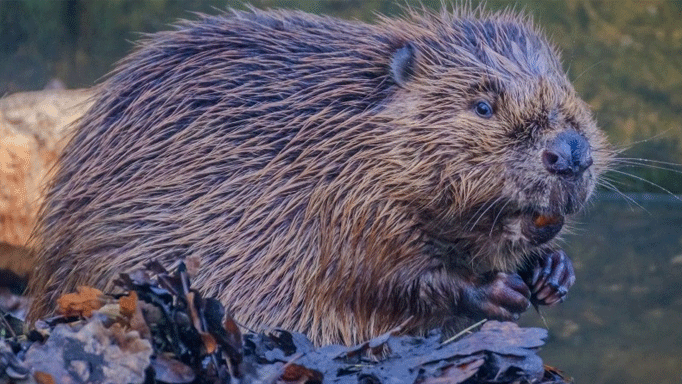A new report by Catherine Wilson, of Loughborough Geography and Environment, examines the process of restoring the beaver population to England after they were hunted to near extinction about 400 years ago.
The large rodents can weigh as much as 30kg – the same as an average 10-year-old – and measure well over a metre from head to tail. They live in streams, rivers and lakes near to woodland and eat aquatic plants, tree bark and leaves.
Interest in bringing back beavers has grown since the 1990’s and this has resulted in beavers being brought into England and being kept in large-fenced enclosures in naturalistic habitat settings as release into the wild is not currently permitted.
All lawful releases of beavers into these enclosures occur under the licence of Natural England. Some think that these enclosures are a step towards official reintroduction of beavers into England.
The creation of these enclosures and subsequent release of beavers could not happen without the support of the licensees – there are more than 27 licensed enclosures in England, 17 of which took part in the research.
The study had two key aims: the first was to understand the motivations and opinions of licensees with beaver enclosures on their land and to understand their experiences of living or working alongside beavers.
The second aim was to examine the human and beaver activities occurring in the enclosures.
Catherine said: “In England, small family groups of beavers are being established within naturalistic enclosures. However, the English landscape has changed dramatically over the last 400 years and the reintroduction of beavers is not simple.
“From the beginning of this research, it was apparent that the release of beavers into these enclosures was not only about the beavers but about the entire ecosystem.
“Although licensees had a range of objectives for releasing beavers, the ecological benefits were the most prevalent.
“Beavers are ecosystem engineers and their ability to dam waterways and create beaver canals results in the creation and maintenance of complex wetland habitats.
“Beaver-modified habitats can support biodiversity, reduce downstream flooding, and improve water quality.
“The research found that there is a large effort is being made across the licensed enclosures to monitor wildlife – particularly birds and bats – as well as vegetation, hydrology, and water quality.
“The results of this research can be used to guide potential future beaver reintroductions.”
The report identified that across the beaver enclosures, licensees are contributing to monitoring efforts.
Beavers are known to provide ecological benefits such as increasing biodiversity, reducing downstream flooding and improving water quality – which is currently being monitored by licensees in an English context.
It also highlighted the importance of artificial structures – including lodges, where beavers sleep – being added to outdoor enclosures before the beavers were introduced into the environment.
Of the 10 manmade lodges created in the woodlands, eight were adopted as homes by the animals.
Lodges, dams and beaver ponds were the most commonly added artificial structures. Eighty-four percent of the artificial structures and modifications installed into enclosures were used at some point by the beavers.
Licensees participating in the interviews identified seven key objectives for releasing beavers into the enclosure:
- for ecological purposes
- to provide benefits to waterways (including preventing drought and flooding)
- for engagement purposes
- for future wild releases
- to advance knowledge
- for personal enjoyment
- for the presence of beavers
Three data collection methods were used during the research: licensee interviews, a licensee survey and beaver consultant interviews. Natural England staff also contributed to the content of the survey.
The key findings included a clear difference of opinion among licensees and consultants as to whether the enclosures represented captivity or not.
Interest in the status of beavers as wild or captive arose from interviews with two beaver consultants. When discussing beaver behaviour one beaver consultant said that the enclosures allowed beavers to:
“…live their lives as wild beavers would, without really bothering that much about the fences…”
In contrast, another consultant said they did not think enclosures could replicate natural beaver territory:
“A strong issue for me is people do see these as wild animals and they're like oh naturalistic enclosures they're living wildly… I think that's one of my biggest frustrations really, reminding people these are captive, you know, whether you see them every day or not these are still captive animals therefore, no enclosure can ever truly replicate beaver territory…”
The report also outlines what some of the interviewees regarded as important factors for potential future successful reintroduction:
- increased collaboration between licensees, stakeholders, the public, Natural England and other potential partners
- employment of beaver officers
- training and education
- the availability of funding for those who may experience conflict
The report has been published by Natural England – a statutory nature organization and the Government’s advisor on the natural environment.
It has been providing advice to help inform the Government’s decision and policy on the legal status, further reintroduction and management – including licensing – of beavers more widely throughout England.
Dr Claire Howe, of Natural England, said: “Our aim is to restore beavers to the English Landscape, ensuring wild releases – if, and when, permitted - are well-planned adopting a careful approach recognising the concerns of some stakeholders and helping people adapt.
“We are excited to support the restoration of beavers and we are supportive of bringing back beavers initially in places where they will bring the most benefits especially where the creation of wetlands and water retention will improve habitat and water quality, and ultimately species diversity and resilience but also avoiding the places where they will incur significant negative impacts.”
